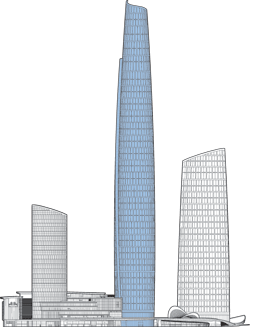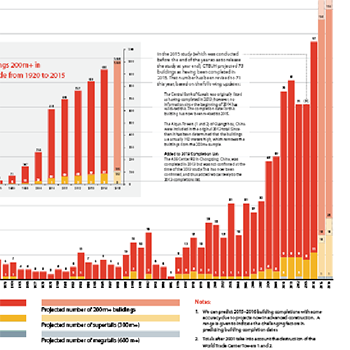Filter by
You must be a CTBUH Member to view this resource.

Chongqing International Trade and Commerce Center
Complex
Architecturally Topped Out
hotel / office / retail / serviced apartments
10,019
Note: Only buildings that have GPS coordinates recorded are displayed.
|
RANK
|
Name
|
Completion
|
Height
|
Floors
|
Function
|
|---|---|---|---|---|---|
| 1 | International Land-Sea Center | 2024 |
458 m / 1,503 ft |
98 | Hotel / Office |
| 2 | Corporate Avenue 2 | 2014 |
256 m / 839 ft |
47 | Office |
| 3 | Corporate Avenue 10 | - |
250 m / 820 ft |
N/A | Office / Retail |
| 4 | Corporate Avenue 9 | - |
200 m / 656 ft |
N/A | Office / Retail |
| 5 | 8 Corporate Avenue | 2014 |
180 m / 591 ft |
37 | Office |
| 6 | Chongqing International Trade and Commerce Center 3 | - |
175 m / 573 ft |
38 | Serviced Apartments / Hotel |
| 7 | 7 Corporate Avenue | 2014 |
155 m / 508 ft |
31 | Office |
| 8 | Corporate Avenue 3 | 2013 |
135 m / 443 ft |
31 | Office |
| 9 | 6 Corporate Avenue | 2014 |
121 m / 396 ft |
24 | Office |
| 10 | Corporate Avenue 4 | 2013 |
100 m / 327 ft |
23 | Office |
| 10 | Corporate Avenue 5 | 2013 |
100 m / 327 ft |
23 | Office |
13 October 2016 - CTBUH Research
31 December 2014 - CTBUH Journal

31 December 2014
Daniel Safarik, Antony Wood, Marty Carver & Marshall Gerometta, CTBUH
An All-Time Record 97 Buildings of 200 Meters or Higher Completed in 2014 and 2014 showed further shifts towards Asia, and also surprising developments in...

20 June 2022
The International Land-Sea Center, a 458.2-meter-tall skyscraper had its roof sealed on Saturday, 18 June 2022. The total length of the building’s butt welds is over...
13 October 2016
The Council is pleased to announce the Top Company Rankings for numerous disciplines as derived from the list of projects appearing in 100 of the World’s Tallest Buildings.
Subscribe below to receive periodic updates from CTBUH on the latest Tall Building and Urban news and CTBUH initiatives, including our monthly newsletter. Fields with a red asterisk (*) next to them are required.
View our privacy policy